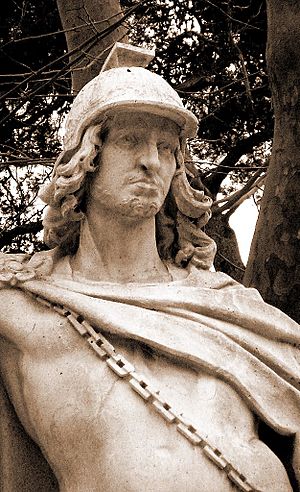Alejandro Carnicero facts for kids
Quick facts for kids
Alejandro Carnicero
|
|
|---|---|

King Wamba
Royal Palace of Madrid |
|
| Born | 1693 |
| Died | 1756 |
| Nationality | Spanish |
| Known for | Sculpture |
| Movement | Baroque |
Alejandro Carnicero (born in Íscar in 1693, died in Madrid in 1756) was a famous Spanish sculptor. He lived during the Baroque period, a time when art was very grand and dramatic. He was part of the Castilian school of sculptors, which means he worked in a style similar to other artists from that region, like Gregorio Fernández. Over time, his art became softer and more elegant, moving towards the Rococo style.
Alejandro Carnicero studied art in Salamanca with a teacher named José de Larra Domínguez. He mostly created his sculptures in the central and northern parts of Spain. Interestingly, three of his sons, Gregorio, Isidro, and Antonio Carnicero, also became artists, following in their father's footsteps.
Carnicero worked with José de Larra for five years on a big project. They created the beautiful wooden choir-stalls for the Salamanca Cathedral. He is also believed to have worked on the choir-stalls in the monastery of Guadalupe. In 1728, he created some of his best work. A religious group called the Carmelites asked him to make wooden figures of the Virgin of Carmen.
In 1730, Carnicero started carving stone medallions of kings. These round sculptures were made to be displayed in Salamanca's Plaza Mayor, a famous town square. After that, he carved a wooden figure of Saint Michael for a hospital. From 1745 to 1750, he worked on four wooden figures for the León Cathedral. Later, he was asked to create three stone statues of Spanish kings for the Royal Palace in Madrid.
Works
Alejandro Carnicero created many different types of sculptures. A large part of his work was religious art, made for churches and monasteries.
- Religious Works:
- Pasos for the Brotherhood of the Vera Cruz in Salamanca. These are large sculptures carried in religious parades.
- Figures of the Virgin of Carmen and Simon Stock in Salamanca.
- Works in the Cathedrals of Salamanca, Plasencia, León, and the Royal Monastery of Guadalupe.
He also made important sculptures for public places and palaces.
- Civilian Sculptures:
- Medallions (round sculptures) in the Plaza Mayor de Salamanca.
- Statues of the Kings of Spain for the Royal Palace of Madrid.
See also
 In Spanish: Alejandro Carnicero para niños
In Spanish: Alejandro Carnicero para niños

